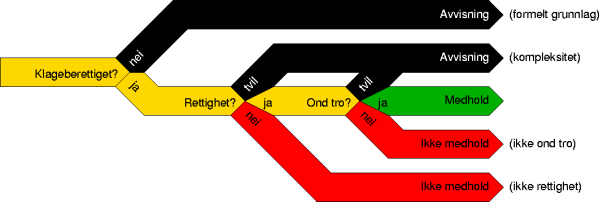The ADR Committee is intended as a rapid and low-cost alternative to the courts of law. It is therefore desirable to exercise some caution regarding which types of decision the ADR Committee can make. The ADR Committee must make decisions within the policy that applies to the .no domain, and is restricted to deciding whether a domain name is to be deleted or transferred from the respondent to the complainant
The ADR Committee cannot make decisions about compensation or
coverage of costs for the parties, as these are complex issues. In such
cases, the parties must bring the dispute before the courts. Neither can
the ADR Committee make a decision which entails the loss of rights for
parties other than the two involved in the complaint.
A special case is a complaint against a decision made by Norid, where the
ADR Committee may make a new decision.
Procedure for handling complaints in conflicts over rights
Up to now, the majority of the cases that the ADR Committee has
adjudicated comprise complaints that the registration or use of a domain
name involves infringement of the complainant's rights. In these cases the
complainant must document that he or she has rights to a name or
trademark which is identical to or resembles the domain name, and that
the domain name subscriber's registration or use of the domain name was
undertaken in bad faith.
A complaint is initially received by the ADR Committee's secretariat, which
collects the submissions for the complaint from the parties, checks that
both the complaint and the response are submitted using the correct
form, and asks for corrections if the complainant or domain name subscriber
has not filled in the form in accordance with the guidelines. At present,
Norid functions as the secretariat for the ADR Committee.
After this, the case goes to the ADR Committee. If both the parties have
requested it, mediation is undertaken. If no mediation is undertaken or if
the mediation does not succeed, the case proceeds to adjudication by the
ADR Committee. Depending on the ADR Committee's assessment, the case
has one of three outcomes (see the figure).

Entitled to complain?
no - Refusal (formal reasons)
yes -Right to domain?
doubt - Refusal (complexity)
yes - Bad Faith? yes Upheld
no - Dismissed (not bad faith)
no - Dismissed (no right to domain)
The ADR Committee first considers whether the requirements for the form
of a complaint have been fulfilled. These include the requirement that the
complaint relates to a .no domain and that this has been registered after
October 1, 2003, that the correct form has been used and filled in
according to the guidelines, etc. If the ADR Committee establishes that the
requirements as to the form have not been fulfilled and that the
complainant is thus not entitled to complain, the complaint is refused on a
formal basis (black path). If everything is in order, the complainant is
regarded as entitled to complain and the complaint proceedings continue
(yellow path).
The ADR Committee then considers whether the complainant has rights to
the domain name to which the complaint relates. If this question cannot
be resolved on the basis of the documentation which has been submitted,
the case is refused as too complex (black path). If the ADR Committee
finds that the documentation is adequate, but that the complainant has
not documented any rights to the name, the complaint is dismissed
(red path). If the ADR Committee finds that the complainant has
documented rights to the name, the complaint proceedings continue
(yellow path).
If the ADR Committee has found that the complainant has documented
rights to the name, it proceeds to consider the question of whether the
domain name subscriber has registered or used the name in bad faith. Here,
documentation both from the complainant and from the domain name
subscriber is evaluated. If the ADR Committee finds that it cannot resolve this
question on the basis of the documentation it has received, the case is
refused as too complex (black path). If the ADR Committee finds that the
collected documentation shows that the domain name subscriber has acted in
bad faith, it upholds the complaint and the domain name is transferred or
deleted according to what the complainant has requested (green path).
If the collected documentation shows that the domain name subscriber has
not acted in bad faith (for example, because the domain name subscriber
holds rights to the name), the complaint is dismissed (red path).
